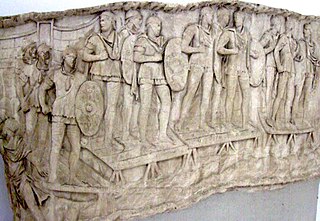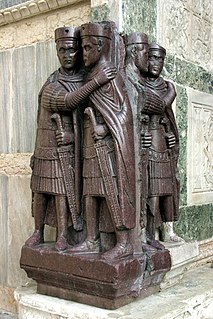
Gallienus, also known as Gallien, was Roman Emperor with his father Valerian from 22 October 253 to spring 260 and alone from spring 260 to September 268. He ruled during the Crisis of the Third Century that nearly caused the collapse of the empire. While he won a number of military victories, he was unable to prevent the secession of important provinces. His 15-year reign was the longest since the 19-year rule of Septimius Severus.

Aurelian was Roman Emperor from 270 to 275. Born in humble circumstances, he rose through the military ranks to become emperor. During his reign, he defeated the Alamanni after a devastating war. He also defeated the Goths, Vandals, Juthungi, Sarmatians, and Carpi. Aurelian restored the Empire's eastern provinces after his conquest of the Palmyrene Empire in 273. The following year he conquered the Gallic Empire in the west, reuniting the Empire in its entirety. He was also responsible for the construction of the Aurelian Walls in Rome, and the abandonment of the province of Dacia.
The Battle of Naissus was the defeat of a Gothic coalition by the Roman Empire under Emperor Gallienus near Naissus. The events around the invasion and the battle are an important part of the history of the Crisis of the Third Century.

Marcus Cassianius Latinius Postumus was a Roman commander of Batavian origin who ruled as Emperor in the West. The Roman army in Gaul threw off its allegiance to Gallienus around the year 260, and Postumus assumed the title and powers of Emperor in the provinces of Gaul, Germania, Britannia and Hispania, thereby founding what scholars have dubbed the Gallic Empire. He ruled for the better part of ten years before he was murdered by his own troops.

Aureolus was a Roman military commander and would-be usurper. He was one of the so-called Thirty Tyrants who populated the reign of the Emperor Gallienus. Of humble Daco-Roman origins, he was 'made' by the Emperor Gallienus and proved himself to be one of the most brilliant and innovative soldiers of the age. However, he later turned against his benefactor, and was destroyed in the political turmoil that surrounded the Emperor's assassination in a conspiracy orchestrated by his senior officers. The ancient sources which refer to Aureolus are limited and the information they do provide is often contradictory. They include the Historia Augusta, Zonaras' epitome and Zosimus' Historia Nova. His career was most recently summarised in John Bray's biography of Gallienus. The analysis of Aureolus's career given here, especially his final rebellion, is largely based on Bray.

Dux Britanniarum was a military post in Roman Britain, probably created by Diocletian or Constantine I during the late third or early fourth century. The Dux was a senior officer in the late Roman army of the West in Britain. It is listed in the Notitia Dignitatum as being one of the three commands in Britain, along with the Comes Britanniarum and Count of the Saxon Shore.
The limitanei or ripenses, meaning respectively "the soldiers in frontier districts" or "the soldiers on the riverbank", were an important part of the late Roman and early Byzantine army after the reorganizations of the late 3rd and early 4th centuries. The limitanei, unlike the comitatenses, palatini, and scolae, garrisoned fortifications along the borders of the Roman Empire and were not normally expected to fight far from their fortifications.
A vexillatio was a detachment of a Roman legion formed as a temporary task force created by the Roman army of the Principate. It was named from the standard carried by legionary detachments, the vexillum, which bore the emblem and name of the parent legion.

The Auxilia were introduced as non-citizen troops attached to the citizen legions by Augustus after his reorganisation of the Imperial Roman army from 30 BC. By the 2nd century, the Auxilia contained the same number of infantry as the legions and, in addition, provided almost all of the Roman army's cavalry and more specialised troops. The auxilia thus represented three-fifths of Rome's regular land forces at that time. Like their legionary counterparts, auxiliary recruits were mostly volunteers, not conscripts.
The structural history of the Roman military concerns the major transformations in the organization and constitution of ancient Rome's armed forces, "the most effective and long-lived military institution known to history." From its origins around 800 BC to its final dissolution in AD 476 with the demise of the Western Roman Empire, Rome's military organization underwent substantial structural change. At the highest level of structure, the forces were split into the Roman army and the Roman navy, although these two branches were less distinct than in many modern national defense forces. Within the top levels of both army and navy, structural changes occurred as a result of both positive military reform and organic structural evolution. These changes can be divided into four distinct phases.

In modern scholarship, the "late" period of the Roman army begins with the accession of the Emperor Diocletian in AD 284, and ends in 476 with the deposition of Romulus Augustulus, being roughly coterminous with the Dominate. During the period 395–476, the army of the Roman Empire's western half progressively disintegrated, while its counterpart in the East, known as the East Roman army remained largely intact in size and structure until the reign of Justinian I.
Volusianus was a Roman citizen, apparently of equestrian origins, whose career in the Imperial Service in the mid-Third Century AD carried him from a relatively modest station in life to the highest public offices and senatorial status in a very few years. He may have secured his first appointments before the Licinian Dynasty - - acceded to the Empire in 253 AD, but it was in the course of their reign that his upward progress achieved an almost unprecedented momentum and the second factor seems to have been a consequence of the first. The nature of his relationship to the Licinii is uncertain, but it seems likely that a common origin in the Etruscan region of central Italy at least predisposed Gallienus in his favour and he seems to have been that emperor's most trusted servant and adviser during the period of his sole reign - 260(?)-268 AD.
A turma was a cavalry unit in the Roman army of the Republic and Empire. In the Byzantine Empire, it became applied to the larger, regiment-sized military-administrative divisions of a thema. The word is often translated as "squadron" but so is the term ala, a unit that was made up of several turmae.

Cohors tertia Delmatarum equitata civium Romanorum pia fidelis, was a Roman auxiliary cohort mixed infantry and cavalry unit.
Cohors prima Delmatarum milliaria equitata was a Roman auxiliary mixed infantry and cavalry regiment. It was named after, and originally recruited from, the Dalmatae, an Illyrian-speaking people that inhabited the Adriatic coastal mountain range of the eponymous Dalmatia.

The equites singulares Augusti were the cavalry arm of the Praetorian Guard during the Principate period of imperial Rome. Based in Rome, they escorted the Roman emperor whenever he left the City on a campaign or on tours of the provinces. The Equites Singulares Augusti were a highly trained unit dedicated to protecting the emperor. Men who served in the Equites Singulares Augusti held a Roman public status as an "Equites".
The Extraordinarii were the elite troops of the Roman alae, recruited from the socii, Rome's Italian military allies. The name refers to their nature; i.e., extraordinary or chosen men.

The equites stablesiani were a class of cavalry in the Late Roman army. They were one of several categories of cavalry unit or vexillatio created between the 260s and 290s as part of a reorganization and expansion of Roman cavalry forces initiated during the reign of Gallienus (260-268). These new cavalry vexillationes typically shared the basic regimental designation equites, and included equites Dalmatae, equites Mauri and equites scutarii.
Lucius Aurelius Marcianus was a Roman soldier whose military career coincided with the period of crisis that characterized the middle decades of the Third Century AD – see Crisis of the Third Century. Probably of humble origins in one of the Illyrician provinces of the Empire he was one of the group of men from this region who chose a military career – or had it chosen for them – whose professional capabilities brought them to the fore of public life in those troubled times. Marcianus rose to the highest levels of the military hierarchy. The evidence suggests that he earned the trust of the Emperors Gallienus and Claudius II and, possibly, Marcus Aurelius Probus among their successors and that he was one of the principal commanders in the prolonged war against a coalition of what the late antique Greek writers called Scythian peoples whose incursions in that period seemed to threaten the very survival of the Roman state. These would refer to the major Germanic and Iranian peoples, among them the Goths and Roxolani, who invaded the Roman empire across the lower Danube River.










